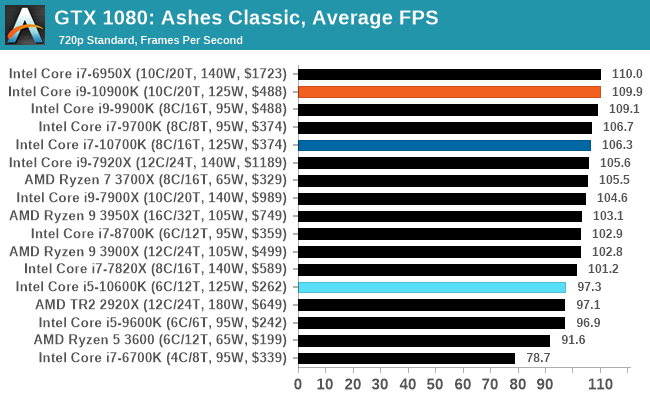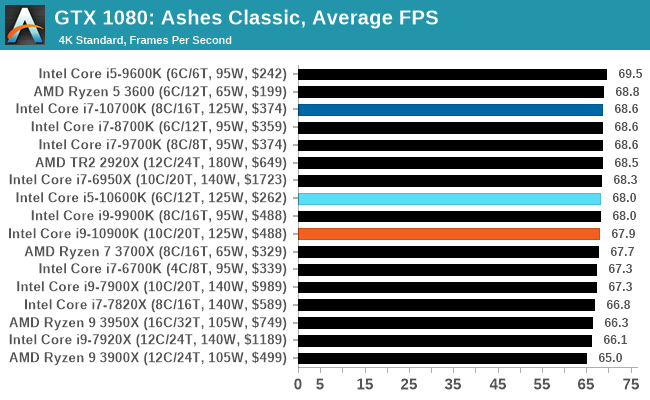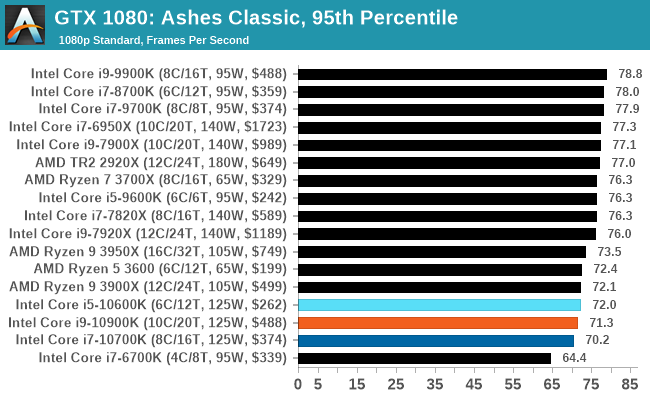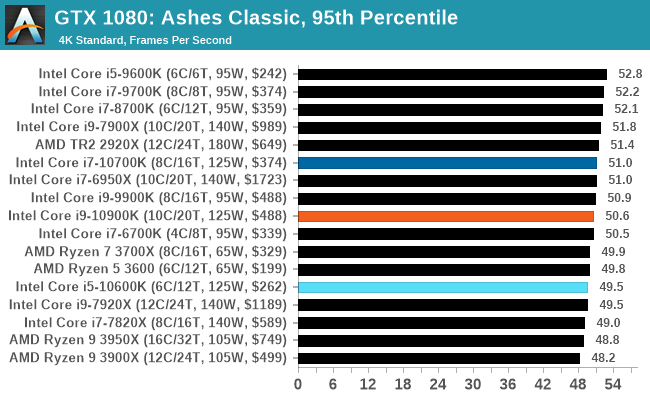The Intel Comet Lake Core i9-10900K, i7-10700K, i5-10600K CPU Review: Skylake We Go Again
by Dr. Ian Cutress on May 20, 2020 9:00 AM EST- Posted in
- CPUs
- Intel
- Skylake
- 14nm
- Z490
- 10th Gen Core
- Comet Lake
Gaming: Ashes Classic (DX12)
Seen as the holy child of DirectX12, Ashes of the Singularity (AoTS, or just Ashes) has been the first title to actively go explore as many of the DirectX12 features as it possibly can. Stardock, the developer behind the Nitrous engine which powers the game, has ensured that the real-time strategy title takes advantage of multiple cores and multiple graphics cards, in as many configurations as possible.
As a real-time strategy title, Ashes is all about responsiveness during both wide open shots but also concentrated battles. With DirectX12 at the helm, the ability to implement more draw calls per second allows the engine to work with substantial unit depth and effects that other RTS titles had to rely on combined draw calls to achieve, making some combined unit structures ultimately very rigid.
Stardock clearly understand the importance of an in-game benchmark, ensuring that such a tool was available and capable from day one, especially with all the additional DX12 features used and being able to characterize how they affected the title for the developer was important. The in-game benchmark performs a four minute fixed seed battle environment with a variety of shots, and outputs a vast amount of data to analyze.
For our benchmark, we run Ashes Classic: an older version of the game before the Escalation update. The reason for this is that this is easier to automate, without a splash screen, but still has a strong visual fidelity to test.
Ashes has dropdown options for MSAA, Light Quality, Object Quality, Shading Samples, Shadow Quality, Textures, and separate options for the terrain. There are several presents, from Very Low to Extreme: we run our benchmarks at the above settings, and take the frame-time output for our average and percentile numbers.
All of our benchmark results can also be found in our benchmark engine, Bench.

| AnandTech | IGP | Low | Medium | High |
| Average FPS |  |
 |
 |
 |
| 95th Percentile |  |
 |
 |
 |











220 Comments
View All Comments
Gastec - Friday, May 22, 2020 - link
Basically you just have to type "allyourbasearebelongtous +$50/surprisemechanic" and you get all the framerate you want in your favorite multiplayer FPShooter.Boshum - Wednesday, May 20, 2020 - link
I think it's a viable alternative to Ryzen 3000, so it's not pointless. It's about equal in performance for most people. A little more expensive and power hungry core for core, but it's more of a flavor thing now. It's still better for certain gaming and application scenarios. Hyperthreading makes the low to midrange a much more reasonable option too, with heat and power being no big deal there. The only place it can't compete with Ryzen is at the very high end for power users doing heavy multi-core work.Dribble - Wednesday, May 20, 2020 - link
I'd be the sort of person to look at a 10700K but power usage is just too high. I want to be able to stick a high end air cooler on it, o/c and still have it run pretty quiet. I'd have to go water with one of these and I can't be bothered with that. Not worth it for the small performance increment over more efficient chips.IBM760XL - Wednesday, May 20, 2020 - link
Agreed. The 10700K and 10900K use more power per core than my ancient-but-trusty 2500K, at least with stock settings. Sure, the new chips get somewhat better IPC, but I can't justify switching from a Sandy Bridge that's nice and quiet even at 100% load, to a Comet Lake that will require Serious Cooling to have an outside chance of being as quiet.I could look at lower-end hex-core Comet Lake chips instead, but why would I do that when I could just as well get an octo-core Ryzen 7 3700, or a Ryzen 5 3600 that will have better performance than an i5-10500?
Boshum - Wednesday, May 20, 2020 - link
I should think the 10500 and 3600 would be pretty close at stock, though you have more overclocking options with the 3600. It's the future Rocket Lake vs Ryzen 4000 options that is more interesting.warrenk81 - Wednesday, May 20, 2020 - link
typo in the dropdown for the final page, move/more.colonelclaw - Wednesday, May 20, 2020 - link
Grammar error, too. Less/fewer.Flunk - Wednesday, May 20, 2020 - link
Well, Intel's back on top for gaming, by a small marging, with chips that can fry an egg. Maybe it'll force AMD to lower their prices on their high-end chips. I don't really fancy a 250+ Watt CPU.DrKlahn - Wednesday, May 20, 2020 - link
You can already get the 3900x for $410 on Amazon. Unless you have a use case that heavily favors Intel that would seem to be a pretty good value already. A good B450 board capable of handling it could be had for not much more than the difference in chip cost (provided that fits your needs).Irata - Wednesday, May 20, 2020 - link
Yup, and like the article says that includes an HSF that will do the job.Contrast that with the 10900k which retails for $530 on Newegg (not available) and which requires you to spend $ 200+ for a proper cooling set up and you are looking at $ 410 vs. $ 730, i.e. paying 56% more for the 10900k. And that does not even include case fans, mainboard, PSU.
If gaming is what one is after, the 9700k looks much more attractive than the 10900k.